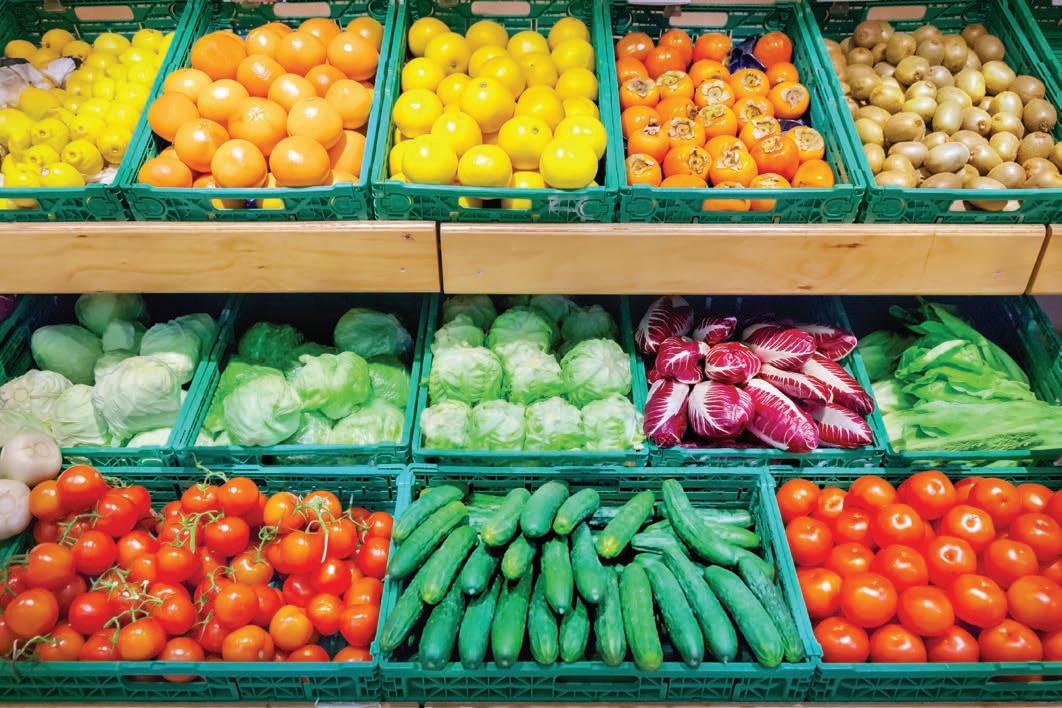
5 minute read
Food justrice programs struggle to survive post pandemic
BY MONTE WHALEY THE COLORADO SUN
A handful of volunteers stooped over a gray patch of soil at FrontLine Farming in Arvada, grooming the stubborn dirt with rakes to prepare for spring planting. Potatoes, onions, greens and root vegetables will be put in the ground later this spring to feed low-income families in the metro area.
Nearby, a small group of chickens clucked against the harsh winds rattling their pen. Bees will soon populate vacant hives and start producing honey, adding to FrontLine Farming’s stockpile of fresh food the 2-acre organic farm provides to struggling households at the edge of the economic abyss.
Frontline Farming is more than just a name, executive director and co-founder Fatuma Emmad said. Many families see FrontLine as the rst and last resort for sustaining their families.
“We are the stewards of the soil and part of that is to provide food for people who are struggling now with food security,” Emmad said. “In ation is causing people to come to us and say, ‘Oh my God, it is just getting harder and harder.’
“And we will be there for them,” she said.
FrontLine Farming produced 120 di erent crops in 2022, including varieties grown from organic, heirloom and climate-adjusted seeds. In all, the farm served 15,000 pounds of food to 195 families or 563 people, Kasey Neiss, the farm’s data activist and systems manager, said in an email. e farm’s 16-week Community Supported Agriculture initiative o ered vegetables and owers from its three farm sites, as well as meats from Wild Boyd Farm in Matheson and mushrooms from Sugar Moon


Mushrooms in Bennett. At least 13 families last season paid for their CSA share with federal SNAP — Supplemental Nutrition Assistance Program — bene ts and received discounted prices through the Double Up Food Bucks program, Neiss said. Sixty families received their CSA share at no cost through the federal Women, Infants and Children produce incentive program.


Neiss said 20% of the farm’s produce was given to food pantries, food shares and food-insecure communities. FrontLine Farming workers also helped le 298 SNAP applications in Denver, Je erson, Adams and Arapahoe counties, she said.
Advocates say SNAP and the Double Up Food Bucks program, which allows SNAP participants to get up to $20 a day more to buy Coloradogrown fruits and vegetables, helped keep families a oat during the pandemic.
But in 2023, both programs that helped keep families fed while they grappled with cutbacks caused by the pandemic are now diminished or in danger of being halted altogether due to shrinking funds.
In March, emergency SNAP bene ts were cut to pre-pandemic levels meaning that an estimated 540,000 low-income families in Colorado collected on average $90 less per month than in the previous two years, advocates say. For a family of four, that amounts to about $360 a month less they can spend on food, according to a news release from U.S. Rep. Yadira Caraveo, a ornton Democrat.
Citing statistics from the Colorado Department of Human Services, Caraveo’s o ce said roughly 77% of SNAP enrollees in the state are working families, people with disabilities or older people with xed incomes. More than half of Colorado’s SNAP households include children.
Meanwhile, a $5 million, ve-year federal grant used to o er incentives to farmers and retailers to continue the Double Up program through the summer is drying up. e enhanced SNAP bene ts allowed families to buy healthier foods and to feed their families in di cult times, Hunger Free Colorado CEO Marc Jacobson said in the Caraveo news release. “Our community members report they are now skipping meals, no longer able to purchase healthy foods and having to make tough choices between food and other necessities,” he said.
Caraveo in April introduced a bill to extend the SNAP bene ts passed in the early COVID-19 relief package. e “Keeping Families Fed Act” has no co-sponsors in Congress, but is earning support from food advocates, who say after the March cuto more hungry families are looking to food banks and other resources for help.
Wendy Peters Moschetti, executive director of Nourish Colorado, a group seeking to increase food access across the state, said the nonpro t is applying to the U.S. Department of Agriculture for another $5 million grant that may arrive in October.
Nourish is meanwhile asking donors to raise $500,000 for the Double Up program to keep it running through the summer. “ ese grants are intended to be received several times — one after the other — so we feel good about our chances, but we just need to get through the summer,” Moschetti said via email.
In an email to prospective donors, Moschetti said the additional $500,000 will help keep Nourish from pausing the Double Up program. “ ese funds will cover incentives for 2023 to help us sustain Double Up without interruptions or cancellations — which we have unfortunately already seen happen in other states.”
High in ation is one of the factors driving up the cost of the program but the most pressing issue is the loss of the pandemic-era emergency SNAP bene ts, she said in another email. ”Double Up will not be halted — but if we cannot meet the demand, the program may need to be limited or paused for a certain amount of time at some partner locations.”
Michigan — where the Double Up program began nearly 15 years ago — has had to pause the program at some partner sites, Moschetti said, “as in limit how much could be spent at their sites and/or limit the months they could o er Double Up.” ey include Zuma Natural Foods in Mancos, Wild Gal’s Market in Nucla, Save A Lot stores in Colorado Springs, Greeley and Pueblo, City Park Farmers Market in Denver and the Boulder County Farmers Markets.
Colorado’s Double Up Food Bucks program is modeled after the Fair Food Network in Michigan, which began at ve farmers markets in Detroit in 2009 and has grown to more than 150 sites across Michigan.
Colorado boasts 76 sites where Food Bucks can be used; most are farmers markets and farm stands, although there are a few permanent stores, Daysi Sweaney, director of healthy food incentives for Nourish, said via email.
Nourish added a few new partners this year but not as many as hoped, Sweaney said.
“We had over 100 applications for this season but could not accept them all due to the uncertainty of funding,” she said. “We want to make sure we can keep all our current partners funded for the rest of the year.” is story is from e Colorado Sun, a journalist-owned news outlet based in Denver and covering the state. For more, and to support e Colorado Sun, visit coloradosun.com. e Colorado Sun is a partner in the Colorado News Conservancy, owner of Colorado Community Media
Expansion is de nitely a priority, Sweaney said, and Nourish wants to bring the Food Bucks program to other areas of Colorado where there is a high need.
1. ANATOMY: What is a common name for lateral epicondylitis?

2. GEOGRAPHY: What was the country of Portugal known as in Roman times?
3. MOVIES: What are the nal words spoken in the movie “ e Shawshank Redemption”?
4. LITERATURE: Which novel series includes a ctional place called Godric’s Hollow, England?
5. SCIENCE: What is cytology?


6. TELEVISION: What is the name of the ranch in the 1960s western show “Bonanza”?
7. U.S. STATES: Which state has the longest cave system?
8. FOOD & DRINK: In which country were bagels invented?
9. HISTORY: What kind of beetle was revered by the ancient Egyptians?
10. ANIMAL KINGDOM: What is the largest lizard on Earth?
Answers

1. Tennis elbow.
2. Lusitania.
3. “I hope.”
4. e “Harry Potter” series by J.K. Rowling.
5. e study of cells.
6. Ponderosa.
7. Kentucky.
8. Poland.
9. Scarab.
10. Komodo Dragon.
(c) 2023 King Features Synd., Inc.









